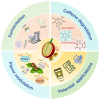Application of Microbial Fermentation in Caffeine Degradation and Flavor Modulation of Coffee Beans
- PMID: 40807542
- PMCID: PMC12346622
- DOI: 10.3390/foods14152606
Application of Microbial Fermentation in Caffeine Degradation and Flavor Modulation of Coffee Beans
Abstract
Coffee is one of the most widely consumed beverages worldwide, primarily due to the stimulating effects attributed to its caffeine content. However, excessive intake of caffeine results in negative effects, including palpitations, anxiety, and insomnia. Therefore, low-caffeine coffee has captivated growing consumer interest, highlighting its significant market potential. Traditional decaffeination methods often lead to non-selective extraction, resulting in a loss of desirable flavor compounds, thereby compromising coffee quality. In recent years, microbial fermentation has emerged as a promising, targeted, and safe approach for reducing caffeine content during processing. Additionally, mixed-culture fermentation further enhances coffee flavor and overcomes the drawbacks of monoculture fermentation, such as low efficiency and limited flavor profiles. Nonetheless, several challenges are yet to be resolved, including microbial tolerance to caffeine and related alkaloids, the safety of fermentation products, and elucidation of the underlying mechanisms behind microbial synergy in co-cultures. This review outlines the variety of microorganisms with the potential to degrade caffeine and the biochemical processes involved in this process. It explores how microbes tolerate caffeine, the safety of metabolites produced during fermentation, and the synergistic effects of mixed microbial cultures on the modulation of coffee flavor compounds, including esters and carbonyls. Future directions are discussed, including the screening of alkaloid-tolerant strains, constructing microbial consortia for simultaneous caffeine degradation for flavor enhancement, and developing high-quality low-caffeine coffee.
Keywords: decaffeination; flavor enhancement; low-caffeine coffee; microbial fermentation; mixed-culture.
Conflict of interest statement
The authors declare no conflicts of interest.
Figures




Similar articles
-
Prescription of Controlled Substances: Benefits and Risks.2025 Jul 6. In: StatPearls [Internet]. Treasure Island (FL): StatPearls Publishing; 2025 Jan–. 2025 Jul 6. In: StatPearls [Internet]. Treasure Island (FL): StatPearls Publishing; 2025 Jan–. PMID: 30726003 Free Books & Documents.
-
Analysis of the formation mechanism and regulation pathway of oat silage off-flavor based on microbial-metabolite interaction network.BMC Microbiol. 2025 Jul 30;25(1):464. doi: 10.1186/s12866-025-04166-2. BMC Microbiol. 2025. PMID: 40739180 Free PMC article.
-
Microbial conversion of vegetable waste for flavor additives via solid-state fermentation: a comprehensive review.Front Nutr. 2025 Jun 24;12:1445189. doi: 10.3389/fnut.2025.1445189. eCollection 2025. Front Nutr. 2025. PMID: 40630173 Free PMC article. Review.
-
The Black Book of Psychotropic Dosing and Monitoring.Psychopharmacol Bull. 2024 Jul 8;54(3):8-59. Psychopharmacol Bull. 2024. PMID: 38993656 Free PMC article. Review.
-
Management of urinary stones by experts in stone disease (ESD 2025).Arch Ital Urol Androl. 2025 Jun 30;97(2):14085. doi: 10.4081/aiua.2025.14085. Epub 2025 Jun 30. Arch Ital Urol Androl. 2025. PMID: 40583613 Review.
References
-
- Cassimiro D.M.J., Batista N.N., Fonseca H.C., Oliveira Naves J.A., Coelho J.M., Bernardes P.C., Dias D.R., Schwan R.F. Wet Fermentation of Coffea Canephora by Lactic Acid Bacteria and Yeasts Using the Self-Induced Anaerobic Fermentation (SIAF) Method Enhances the Coffee Quality. Food Microbiol. 2023;110:104161. doi: 10.1016/j.fm.2022.104161. - DOI - PubMed
Publication types
Grants and funding
LinkOut - more resources
Full Text Sources

